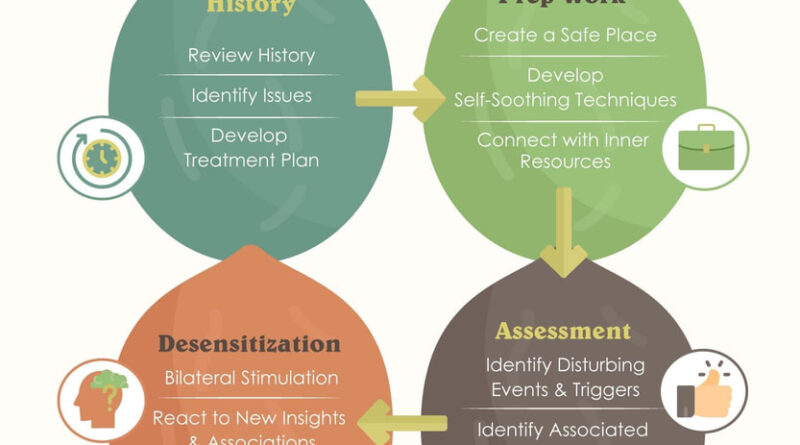EMDR Therapy: A Powerful Approach for Healing Trauma
Trauma can leave deep emotional scars that affect every aspect of a person’s life, from their relationships to their work and overall well-being. Traditional talk therapies can be highly beneficial, but for many, there is a need for an alternative approach that accelerates healing. EMDR therapy (Eye Movement Desensitization and Reprocessing) has emerged as a groundbreaking treatment for trauma and a variety of other mental health issues.
In this article, we will explore EMDR therapy, how it works, its benefits, and what you can expect if you choose this therapeutic approach to heal from trauma and other psychological challenges.
What is EMDR Therapy?
Understanding EMDR Therapy
EMDR therapy is a therapeutic approach that was developed by Dr. Francine Shapiro in the late 1980s. It is designed to help individuals process distressing memories, particularly those related to trauma. The therapy involves bilateral stimulation (often in the form of guided eye movements) while the individual recalls traumatic or distressing memories.
The theory behind EMDR is that trauma can overwhelm the brain’s natural ability to process memories, leaving them “stuck” in the mind. EMDR helps “unstick” these memories by allowing the brain to reprocess the trauma in a way that reduces its emotional charge.
How Does EMDR Therapy Work?
The process of EMDR therapy involves eight phases that work together to help individuals reprocess traumatic memories:
- History Taking: The therapist assesses the client’s history and identifies target memories to focus on during therapy.
- Preparation: The therapist explains the process of EMDR and ensures that the client feels safe and supported throughout the therapy.
- Assessment: The therapist helps the client identify the specific image, negative belief, and emotions associated with the traumatic memory.
- Desensitization: This phase involves bilateral stimulation, typically through guided eye movements, tapping, or auditory cues, while the client focuses on the traumatic memory.
- Installation: Positive beliefs are reinforced during this phase, replacing the negative beliefs associated with the trauma.
- Body Scan: The therapist guides the client to focus on any physical tension that remains in the body related to the trauma.
- Closure: The session ends with techniques to help the client feel grounded and safe.
- Reevaluation: The therapist assesses progress and ensures that the trauma-related memory has been fully processed.
Benefits of EMDR Therapy
1. Rapid Relief from Trauma Symptoms
One of the primary benefits of EMDR therapy is its ability to produce faster results compared to traditional therapy. Many clients experience significant relief from trauma symptoms in just a few sessions. This rapid progress is why EMDR therapy is often recommended for individuals dealing with PTSD, anxiety, or other trauma-related conditions.
2. Reduces the Emotional Charge of Traumatic Memories
Unlike some therapies that only focus on talking through trauma, EMDR therapy directly targets the emotional intensity of the memory. By processing the memory through bilateral stimulation, the emotional charge associated with the memory decreases, allowing individuals to think about the trauma without experiencing overwhelming distress.
3. Healing Beyond Trauma
Though EMDR therapy is most widely recognized for its use in treating trauma, it can also be effective for a wide range of psychological conditions, including:
- Anxiety and panic disorders
- Depression
- Phobias
- Grief and loss
- Chronic pain
- Addictions
- Negative self-beliefs
Through the reprocessing of memories, EMDR therapy can help individuals heal from a variety of emotional wounds and improve their overall mental health.
4. Empowering Clients to Reclaim Control
A key aspect of EMDR therapy is that it empowers individuals to take control of their healing process. Rather than simply reliving the traumatic events, clients are encouraged to process and transform the memories with the support of their therapist. This results in a greater sense of agency and a reduction in the impact of the trauma on daily life.
5. No Need for Long-Term Talk Therapy
For some individuals, EMDR therapy offers a more efficient alternative to traditional talk therapy. While talk therapy involves lengthy discussions about past events, EMDR therapy focuses on reprocessing memories in a way that eliminates the need for extensive verbal exploration. This makes EMDR an excellent choice for individuals who prefer not to focus too much on discussing painful experiences but still need to heal from them.
Who Can Benefit from EMDR Therapy?
People with PTSD
Post-Traumatic Stress Disorder (PTSD) is one of the most common conditions treated with EMDR therapy. Whether due to combat, abuse, accidents, or natural disasters, PTSD can have long-lasting effects on an individual’s mental and physical health. EMDR has proven to be highly effective in alleviating PTSD symptoms, helping individuals reduce nightmares, flashbacks, and anxiety.
Those Dealing with Childhood Trauma
EMDR therapy can also be highly effective for individuals who have experienced childhood trauma, including neglect, abuse, or emotional harm. Reprocessing these memories with the help of a skilled therapist allows individuals to break free from long-standing negative patterns and beliefs rooted in their early experiences.
Individuals Struggling with Anxiety or Depression
Anxiety and depression often stem from unresolved past trauma or negative life events. EMDR therapy helps individuals process these experiences and change the underlying thought patterns contributing to their anxiety and depression. For many, it is a powerful tool for breaking free from cycles of negative thinking.
People with Phobias
Phobias, whether related to specific objects, situations, or events, can be debilitating. EMDR therapy works by addressing the root cause of the fear and reducing the emotional intensity associated with the phobic trigger. Over time, individuals may find that their phobia no longer holds the same power over them.
What to Expect in an EMDR Therapy Session
A Comfortable and Safe Environment
Before starting EMDR therapy, it is essential to find a qualified therapist who specializes in trauma treatment. The therapist will work with you to create a safe and comfortable environment where you feel at ease exploring sensitive memories.
The Bilateral Stimulation Process
During the session, the therapist will guide you to recall specific traumatic memories while providing bilateral stimulation. This may involve following the therapist’s fingers with your eyes, listening to alternating sounds, or feeling taps on your hands or legs. While this may sound unusual, the process is designed to help the brain reprocess the memory in a healthy way.
Gradual Progress
While EMDR therapy can produce fast results, it is still important to recognize that healing is a gradual process. Some clients may need several sessions to fully process all relevant traumatic memories, while others may experience significant improvement after just a few visits.
Conclusion
EMDR therapy is a powerful and effective treatment for those struggling with trauma, anxiety, PTSD, and other mental health conditions. By reprocessing distressing memories and reducing their emotional impact, individuals can experience relief from symptoms and regain control of their lives. If you or a loved one are struggling with trauma or emotional wounds, consider exploring EMDR therapy as a potential solution for healing. Working with a trained and compassionate therapist can help you move forward with confidence and peace of mind.




